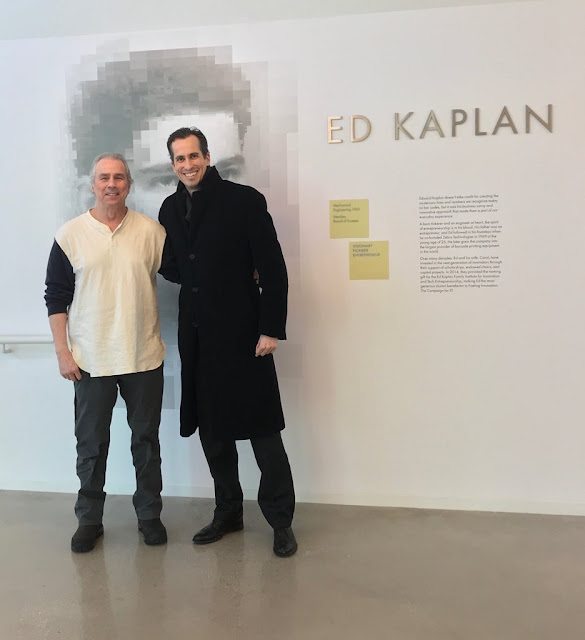Thursday, February 28, 2019
Tuesday, February 26, 2019
New INC Blog Post by Kaplan Institute Exec Director Howard Tullman
How to
Innovate Your Innovation
You
can't just decide that your organization is going to create more breakthroughs.
There's a methodology to creating magic.
Executive director, Ed Kaplan Family Institute for Innovation
and Tech Entrepreneurship, Illinois Institute of Technology
Looks
to me like the curtain on the innovation theater is about to come down. At
1871, the Chicago incubator I ran, we called the constant parade of
well-intentioned but largely clueless visitors and the accompanying startup
charade the "entrepreneurial petting zoo". The visitors' vain hopes
were that, in the course of viewing such a serious concentration of
entrepreneurs, and, by some process akin to osmosis, a little innovation juice
would rub off on them and maybe a radical idea or two would mystically emerge.
Good luck with that. You're a lot more likely to be hit by lightning which,
when you think about it, would certainly be more stimulating. There's got to be
a better and smarter way to create a culture of innovation and help your people
get headed in the right direction.
There's
no magic or madness to successful innovation, but there is a lot of method,
preparation and patience. The best people in the innovation business practice,
iterate and improve their programs all the time. Effective innovation is a
constant, company-wide, process, not a project or a department, which you must
(a) authentically commit to, (b) aggressively organize around, (c) systemically
implement, integrate, and enforce throughout your operations, and then
(d) measure against real metrics on a continuing
basis. It's not some piecemeal placebo or a quick fix panacea. And
innovation is also not about trying to move the needle tomorrow. Small, sure,
incremental steps and a celebration of early victories and results are the way
to go. Good things still take time.
Smart
innovation is based on an overall philosophy and a commitment to try to get a
little bit better across the board, every day, and all the time - not a
one-shot deal or a moonshot deal. Innovation is about what I call
"successive approximation" as opposed to "postponed
perfection, "which never happens anyway, is impossibly costly, and isn't
worth waiting for -- even if it ever showed up.
As a
general proposition, in radically-changing times like these, where the rate of
change continues to accelerate, waiting almost never gets you to a better
result. Elaborate planning, extensive documentation, and expensive research are
all forms of denial, postponement and mental pollution. In the meantime,
critical time passes and opportunities abate, necessary changes aren't made,
key people and partners depart for brighter pastures, and pressing problems
aren't addressed. Sadly, those problems won't lessen or disappear,
they'll propagate and worsen.
So, the
most important thing to do for any organization anxious to change for the
better is to get the process started. But too many companies are doing the same
old things and expecting different results and we all know that simply doesn't
happen. Try as you might, you can't harangue your folks into changing their
long-held habits especially those that worked pretty well in the past, but
which are doomed to fail tomorrow. Saying doesn't make it so. However huge your
hammer is, it's still impossible to nail Jell-O to a tree.
And if
you don't have an overall plan to successfully launch your new initiatives, to
assure that your people throughout the organization are invested in the
process, and to make certain that the changes you need to make will last,
everything else doesn't matter. That's regardless of how many
highbrow courses your people must sit through, whatever attractive financial
incentives you introduce, or how many inspirational notes and memos you send to
the troops.
You've
got to get things right at the beginning; speed doesn't matter unless you're
headed in the right direction. Off by an inch, miss by a mile. So, it's
critical to start straight and strong. The ultimate goal is to have the
innovations you implement stick. You need to be all about gaining
and growing traction and assuring long-term sustainability-
otherwise you're just treading water, upsetting your people for no good reason,
and wasting a lot of time and money. Finis origine pendet-- the
end depends upon the beginning.
There's
a simple problem with the traditional approach that most businesses are still
pursuing--and not merely that the traditional approach doesn't last over time or
produce real results. Much more insidious is the fact that it destroys your
company's culture. False starts, repeated half-assed attempts, and continued
failures send a message throughout your company that senior management doesn't
really care about innovation and change - even though your best and brightest
employees absolutely do. They all know that, if your business doesn't embrace
change, it will eventually die and, quite frankly, they're not likely to stick
around for the slow and painful funeral.
Great
companies and cultures are built when the employees sincerely believe that
their leaders are putting them first. You may have your own reservations and
even some doubts, but you've got to have faith in the people you're leading.
Your job is to get your people from where they are to where they've never been
and to show them a vision and a path to get there. You don't do that by sending
Sam and Mabel to San Francisco for a two-day strategy session. The sour dough
bread may be great, but the substance is increasingly suspect.
You
need a better and smarter plan than simply shipping a few of the folks to the
latest and greatest seminar to drink the new Kool-Aid and hope they come back
and inspire the team. They'll return only to find that they're trying to push a
rope and convince a bunch of non-believers to change in ways that they're not
even sure their management believes in. A couple of converts can't change a
company's culture by themselves. Save your breath and your money - it doesn't
work. I'm not certain that it ever did, but it's DOA today for sure.
The
good news is that I've seen a better solution. Tom Kuczmarski, the founder
of Kuczmarski
Innovation, has taught innovation and executive education for more than 30
years at topflight universities to more than 7,500 leaders from a wide variety
of industries. Over the last few years, he had consistently observed a
recurring structural problem and he's figured out a better way to go. Companies
weren't getting their innovation efforts off on the right foot because they
didn't understand the four basic requirements for long-term sustainable
success:
(1) Alignment-
Senior leaders need to visibly commit to and participate in/attend initial innovation
training sessions and final presentations because the depth and breadth of
company-wide engagement is critical; step one is for the senior management
participants to define and develop a clear strategy and some target
opportunities;
(2) Instruction-
Multiple junior team members attend training sessions where they learn to apply
the best new practices and tools for identifying specific opportunities and
implementing innovative solutions within their organizations for the precise
problem areas identified by senior management; step two trains the innovation
team and points them in the right direction as well as coaching them along the
way;
(3) Application-
Actual problem areas and potential solutions within the organization are
identified in progress discussions between the senior management attendees and
the innovation team members and specific innovation initiatives are authorized,
described and developed; step three advances the process and makes the proposed
solutions concrete and real rather than dealing in theoretical situations or
wishful thinking;
(4) Activation and Implementation-
Team members return to the organization with a plan, timetable, management
endorsement and support, and the tools they need to be successful in addressing
actual problems and issues and, more importantly, overcoming resistance,
inertia and internal obstacles; step four delivers the expected and sustainable
results.
Kuczmarski
Innovation has developed a new two-phase course ("Managing and Activating
Innovation") for training leaders throughout an organization to develop
readily achievable and sustainable innovation solutions for their businesses,
which incorporates all the foregoing objectives. It avoids many of the past
cultural, sponsorship and implementation problems and delivers both results and
a demonstrable ROI. It's a brief, practical, and hands-on program
that combines traditional faculty and experienced industry professionals. Full
disclosure: I've seen the materials and I'm hoping to be one of the lecturers in
the program myself this summer.
But, in
the final analysis, I think it works so well because it quickly connects and
engages a critical mass of interested parties across various levels of the
business and because it sends a most important and empowering message
throughout the culture: the best leaders don't create followers; they create
more leaders.
PUBLISHED
ON: FEB 26, 2019
Monday, February 25, 2019
Game over - Digital Tribune
Game over
It seems we’re reaching the end of the Ping-Pong and pool table period.
It couldn’t come soon enough for me. Something just feels different these days, and maybe it’s a growing need to hunker down a bit and take the task of “taking care of business” a lot more seriously.
Let’s dial back leisure in the office, lower the volume on the whining and worrying about hurt feelings, and double down on sweat and toil.
We call it “work” for a reason and, while it can certainly be plenty stimulating and rewarding, work is not intended to be all fun, all the time. Never was.
There’s still no substitute for hard, purposeful work and no more likely path to eventual success. Talent and creativity are great, and should certainly be encouraged, but effort and execution are what really matter.
These aren’t the frothy, kombucha-and-beer times of yore any longer.
Global competition is rising, a recession is almost certainly on the horizon (it’s only a question of when), and when the market and the investors start seriously keeping score, all the touchy-feely awards for “the very best place in the whole wide world to work” aren’t gonna matter much if your team isn’t monetizing your business and putting some real numbers on the bottom line.
The thought of a bunch of clowns playing Pong (analog or throwback digital) in the middle of the day while other team members are busting their butts trying to get a new software release out the door no longer computes.
Camaraderie is crucial in any new business, but it’s important to make sure that it comes from the shared pride of completing what needs to get done, not solely from Thursday night shots, smelly cigars and card games.
That also includes the pinball machines, foosball tables and the pool table, which is just as passé today as the phony masse shot that Matthew McConaughey makes in the latest Lincoln Navigator TV ad.
Real company cultures are built on respect, recognition and well-earned rewards, not free food, laundry services and recreational resources.
Your customers don’t really care about the perks, the toys or the cereal selections in your break room. When their system’s not working, they want the best software engineer on the case, not the guy who racked up the highest score playing pinball.
And your best and most important employees don’t really care about all this nonsense, either. They’re the ones who are head-down and have no time to fool around.
Businesses rapidly become the behaviors that they tolerate, and it only takes a few slackers and snowflakes to suck the life, energy and momentum out of any startup. Part of the job is to make sure that doesn’t happen.
When people are struggling to answer too many incoming customer calls or polishing a PowerPoint for an important funding pitch, or cold-calling piles of prospects, it seems foolish to show up at a meeting late because you were tapping the keg or sitting on a beanbag chair playing a video game.
You don’t really want to be the office’s social director and party person. The goal is to be the “go-to” guy — not the mope you’d probably have a drink with, but never count on for much of anything else.
Late night and after-hours bonding activities might be fine, but what authentic entrepreneur has ever had regular office hours to? In the real world, you work until you’re about to fall over and then you go home so you can pick yourself up in the morning and do it all over again.
If you want to build a serious business, that’s the behavior you want to model. That’s what people inside and outside the business pick up on. Passion and commitment make a difference.
You want to build a team that finds its satisfaction in achievements and accomplishments and not one that’s fixated on freebies and fresh fruit. If you have to bribe your people with goodies or otherwise convince them to work hard and do their best, you’ve got the wrong people and you’re sending the wrong message.
And if you think having a Ping-Pong table in the office makes you look cool, you’re wrong.
It’s all about revenues and results, not refreshments and recreation.
Sunday, February 24, 2019
CEOs THAT SELL
CEOs THAT SELL
https://chicagoventuremagazine.com/2018/03/09/ceos-and-sales/
 Why Startup CEOs Still Have to Make Sales Calls
Why Startup CEOs Still Have to Make Sales Calls
by Howard Tullman
.
It’s not your strength, or maybe not even what you enjoy doing. But being there to close the deal isn’t something you can simply hand off to the sales team.

At what point can a CEO turn sales over to professional salespeople? Before that can happen, the company has to achieve two foundational milestones:
- You need to know exactly what you’re selling—by doing it over and over again (and not as a one-off).
- You need to know for certain that others can sell it consistently.
That only comes with the maturity of your product/service. Until it reaches that point, stay in the field and keep selling. Your product is still being developed on the fly and continually redesigned/reconfigured to better suit the real requirements and demands of customers. The fact is, ultimately only you can make the critical design and development decisions and you’ll do a much better job of that if you are hearing it directly from the end users and not from a bunch of whiny salespeople.

I’m seeing more and more startup CEOs who discover way too soon that they don’t like the wear and tear, the travel, and the rejection that are all crucial parts of selling a new product or service. So they retreat, thinking they can run their businesses while they’re sitting on their butts behind a desk back in the office. That’s not how this game works; that behavior is a formula for failure. You may not be an extrovert. You may not even know the technology that underlies your business as well as half the other people in the company. You are, however, the boss and today that fact alone means a lot, at least to the people who make the final purchasing decisions.
Remember—buyers are typically older than you, they grew up in strictly hierarchical systems where titles count, and they need to be made to feel important and respected if they’re gonna sign off on your deal. No offense to any of the members of your team, but customers don’t want to deal with the monkey—they need to see the organ grinder. That’s you. And they want you for all the obvious reasons:
- People don’t really care how much you know until they know how much you care. Show up. It’s important.
- Startup staffs are notoriously scattered and hurried—lacking focus and attention to detail. Customers want to know that you personally are connected, paying attention and directly engaged with their business, their concerns, and their problems.
- Clients want to hear it from the horse’s mouth. Not second hand. They want commitments and assurances from you. Everybody knows that the sales guys will say anything and promise them the world. They need assurance that you will stand behind your product or service and make good on your promises. The buck always stops with you.

Product Maturity
Once your product/service reaches those critical milestones, it’s time to kick yourself upstairs and focus on other things. I encourage CEOs who find they spend too much effort selling to optimize their time. I suggest that they find competent sales managers and others who can tee up just the right meetings for them—not opening meetings which are a dime a dozen, but closing meetings where the deals get done.
Finding sales meat-eaters to fill managerial roles isn’t easy; they are the hardest hires for any startup, but it’s absolutely critical to have them onboard if you’re going to build a viable business.
When your startup is hiring talent, you need to avoid certain categories of salespeople. For example, stay away from what I call empire builders. There’s a whole generation or two of sales management types whose experience comes only from large organizations. I have found fairly consistently that they are the wrongest guys possible for a startup because they grew up in a system where they measured their value and their success by the sheer number of people they managed rather than the results that those folks delivered. Nothing kills a young business faster than bloat and bureaucracy and having too many sales people sitting on their hands and not selling is the worst kind of poison. So be careful what you wish for and who you hire for this critical job.
There’s no more challenging job than being the CEO. You are responsible for the health of each part of the organization and the trajectory of the entire venture. Stay in the sales loop until your product/service matures. Then focus on closing deals. Customers need you to be there—to say what you’ll do, and do what you say.
■
Howard Tullman is the Executive Director of the Kaplan Institute at Illinois Institute of Technology and the former CEO of Chicago-based 1871, where 500 digital startups are building their businesses every day. He is also the general managing partner of G2T3V and Chicago High Tech Investors, both early-stage venture funds; a member of Mayor Rahm Emanuel’s ChicagoNEXT Innovation Council and Governor Bruce Rauner’s Innovate Illinois Advisory Council. He is an adviser to many technology businesses and an adjunct professor at the Kellogg Graduate School of Management.
@tullman
This article is an excerpt of one that appeared recently in Inc.
Image Credits – Getty Images, MS Office, Howard Tullman
Chicago Venture Magazine is a publication of Nathaniel Press www.ChicagoVentureMagazine.com Comments and re-posts in full or in part are welcomed and encouraged if accompanied by attribution and a web link. This is not investment advice. We do not guarantee accuracy. Please perform your own due diligence. It’s not our fault if you lose money..Copyright © 2018 John Jonelis – All Rights
Friday, February 22, 2019
Thursday, February 21, 2019
Wednesday, February 20, 2019
Tuesday, February 19, 2019
New INC. Magazine Blog Post by Kaplan Institute Exec Director Howard Tullman
You Can Hear
More If You Learn to Listen
The
art of shutting your yap and opening your ears isn't an easy one to learn for
entrepreneurs. But it is an essential skill and a potential competitive
advantage.
Executive director, Ed Kaplan Family Institute for Innovation
and Tech Entrepreneurship, Illinois Institute of Technology
There's
absolutely nothing harder or more important for any entrepreneur to learn than
how to listen, carefully and effectively. To everyone in your life -
family, friends, and peers. And to everyone in your business - customers,
investors and directors. One of my favorite INC. pieces is called "What I Learned from My Waitress",
which I wrote years ago and which I re-read every so often just to remind
myself how important listening is. For young entrepreneurs,
listening is a skill to master. For more seasoned entrepreneurs, it's a skill
that's easy to forget because we figure we already know everything. Seems that
as you get older, not only your hearing goes, but quite often so does your
listening.
Aggressive
listening is a professional practice that takes vigilance and constant exercise
because the inbound messages are continually changing and only rarely do they
present themselves on a silver platter. In fact, by the time they eventually
become obvious, it's usually (and painfully) too late to do anything
effectively about them. That's the exact inverse of good ideas. By the time
everyone agrees that they make sense, it's too late to make anything valuable
out of them.
The
best businesses listen carefully, adapt quickly and respond immediately to the
progressive and ever-expanding demands of their customers. And
"customers" in this context means a cluster of constituencies far
more populous than simply the actual consumers of their products and services.
Vendors, partners, media, regulators, legislators and even competitors are all
part of the essential mix. And, in some ways, keeping a careful eye on your
competition might be the most important job of all.
Listening
to competitors isn't something you do because you necessarily plan to react to
or replicate everything they're doing. You do it because you might learn a lot
from them about what not to do or even things - amazingly enough - that
you could and/or should be doing. Good companies rarely lose to the
competition; they lose because they've lost their way internally and they no
longer understand what it takes to satisfy their customers. They take
themselves out of the game through indifference, inattention, or simple
ignorance. Today, it pays to pay attention and be willing to learn from
everyone because someone else may have simply figured things out sooner than
you. In fact, given the pace of change these days, the ability to learn
faster than your competition might be the only remaining and sustainable
competitive advantage. If you're not listening, you learn nothing.
Our
daily lives are so cluttered and noisy, and the constant flow of information is
so overwhelming, that we are, increasingly and of necessity, opting to filter
out, simplify, and often just outright ignore potentially critical data and
other inputs. Because we have no time to do otherwise. Think of this as
attention triage. We take our best guess and our best shot, and we keep our
fingers crossed that we didn't let any of the really good stuff slip by while
we weren't looking.
FOMO is
very much alive and well although it's more properly called information anxiety
in this case. We're constantly jumping from place to place, source to source,
and site to site and we're spending less and less time at each stop along the
way. So, we're gathering and absorbing less and less. In this
frantic and "phygital" world, we're all like dogs chasing squirrels.
And, of
course, the easiest things to shut off (and shut out) are the things that we've
already decided we disagree with. Why would anyone waste time listening to
someone whose views are so clearly and demonstrably wrong-headed? Our
technologies increasingly cater to and abet this studiously ignorant approach -
they feed us what we want to see and hear so we'll stick around. The filter
bubble makes it almost impossible to discover anything new or
different. It's always the same old news. And the process spirals
ever more inward where we seek out only those views and visions which reinforce
and comfort our cozy little world views.
But
there's a way to break this vicious cycle if you're willing to learn to listen
in a new way. This isn't pretending to listen while you're actually just
waiting to talk. And it's not tuning the talker out as you plan your next
remarks. This is about listening in a way that makes it possible to learn. And
there are several keys to learning how to listen effectively.
(1) Listen
even if you don't like what you're hearing. Tune in, rather than tuning out.
(2) Listen
with the specific intent to try to understand where the other person is coming
from. To hear their side of the story and their perspective.
(3) Listen
to understand the real differences between you and the other side because they
might be a lot less substantial than you think.
(4) And
finally, ask what the others really need to get to some agreement.
I
learned this last lesson from the new Bohemian Rhapsody movie.
Freddie Mercury and the guys have had their final falling out and now he's
trying to get the band back together for one last performance. There's plenty
of hard feelings and tough talk to go around and things don't seem to be going
anywhere.
And
then Freddie asks his mates a simple question: "What's it going to take
for you all to forgive me?" This is an open-ended question, but
it helps to move the conversation from feelings to facts and, while the demands
may not be realistic or reasonable or achievable, at least they're out there on
the table and up for discussion. Sometimes all those differences and
disputes are far more manageable than anyone might have imagined.
All it
often takes is taking the time to listen.
Friday, February 15, 2019
Managing and Activating Innovation
CLICK HERE TO LEARN MORE
Executive Education That Matters
Go beyond what you learn in a typical executive education course to drive real change by developing concrete ideas that can be put to work in your business immediately.
Engage innovators at every level of your organization in a program that extends seven days of classroom work into three months of accelerated progress towards achieving your growth, innovation and productivity goals.
Thursday, February 14, 2019
Wednesday, February 13, 2019
Subscribe to:
Comments (Atom)
LINKS TO RELATED SITES
- My Personal Website
- HAT Speaker Website
- My INC. Blog Posts
- My THREADS profile
- My Wikipedia Page
- My LinkedIn Page
- My Facebook Page
- My X/Twitter Page
- My Instagram Page
- My ABOUT.ME page
- G2T3V, LLC Site
- G2T3V page on LinkedIn
- G2T3V, LLC Facebook Page
- My Channel on YOUTUBE
- My Videos on VIMEO
- My Boards on Pinterest
- My Site on Mastodon
- My Site on Substack
- My Site on Post
LINKS TO RELATED BUSINESSES
- 1871 - Where Digital Startups Get Their Start
- AskWhai
- Baloonr
- BCV Social
- ConceptDrop (Now Nexus AI)
- Cubii
- Dumbstruck
- Gather Voices
- Genivity
- Georama (now QualSights)
- GetSet
- HighTower Advisors
- Holberg Financial
- Indiegogo
- Keeeb
- Kitchfix
- KnowledgeHound
- Landscape Hub
- Lisa App
- Magic Cube
- MagicTags/THYNG
- Mile Auto
- Packback Books
- Peanut Butter
- Philo Broadcasting
- Popular Pays
- Selfie
- SnapSheet
- SomruS
- SPOTHERO
- SquareOffs
- Tempesta Media
- THYNG
- Tock
- Upshow
- Vehcon
- Xaptum
Total Pageviews
GOOGLE ANALYTICS
Blog Archive
-
▼
2019
(377)
-
▼
February
(26)
- Chicago Tech and Innovation Outlook
- New INC Blog Post by Kaplan Institute Exec Directo...
- Game over - Digital Tribune
- CEOs THAT SELL
- Kaplan Institute Welcomes Andrei and Mihai Hogea -...
- Hollywood History at LAX
- THE FUTURE OF INNOVATION AND TECH - PODCAST WITH H...
- Kaplan Institute Welcomes Jim Todd
- Kaplan Institute Exec Director Howard Tullman Spea...
- New INC. Magazine Blog Post by Kaplan Institute Ex...
- Kaplan Institute Welcomes Upshow CEO Adam Hirsen
- Kaplan Institute Welcomes IIT Trustee and KI Board...
- Managing and Activating Innovation
- Kaplan Institute Welcomes Manasa Maddila
- Kaplan Institute Welcomes Thomas Galbraith
- NEW HAT SPEAKER WEBSITE LAUNCHED - SPECIAL THANKS...
- 2019 Edelman Trust Barometer
- Kaplan Institute Exec Director Howard Tullman Keyn...
- New INC Magazine Blog Post by Kaplan Institute Exe...
- Trust Me...
- Bret Stephens The Progressive Assault on Israel
- Kaplan Exec Director Howard Tullman Keynote at The...
- Nayar Prize Ceremony at Kaplan Institute
- New INC Magazine Blog Post by Kaplan Institute Exe...
- Kaplan Institute Exec Director Howard Tullman Appe...
- Kaplan Institute Welcomes Team from Five to Nine f...
-
▼
February
(26)














































